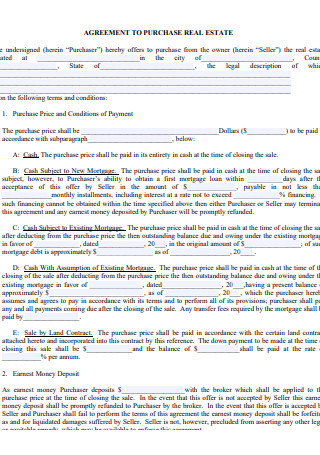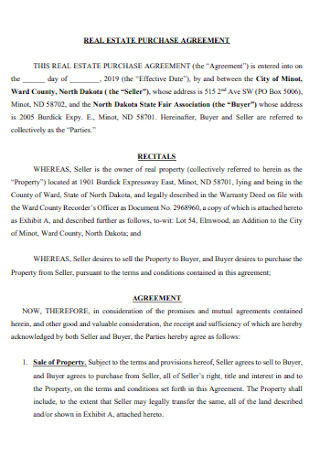10+ Sample Real Estate Purchase Agreements
-

Residential Real Estate Purchase Agreement
download now -

Agreement to Purchase Real Estate
download now -

Real Estate Land Purchase Agreement
download now -

Simple Real Estate Purchase Agreement
download now -

Real Estate Purchase and Sales Agreement Template
download now -

Formal Real Estate Purchase Agreement
download now -

Land Purchase and Sale Agreement
download now -

Agreement to Sell Real Estate
download now -

Real Estate Purchase Sale Agreement
download now -

Addendum to Real Estate Purchase Agreement
download now
FREE Real Estate Purchase Agreement s to Download
10+ Sample Real Estate Purchase Agreements
What is Real Estate Purchase Agreement
Other Types of Real Estate Agreements
How to Make a Real Estate Purchase Agreement
FAQs
Is it okay for a seller to cancel a purchase of agreement?
What are real estate fixtures?
What does a legal description of the property mean?
What is Real Estate Purchase Agreement
A purchase agreement for real estate is a binding agreement, when the seller and the purchaser agree to sell a property. This contains the property specifications, the purchase price, the down payment, payment terms and any conditions and contingencies agreed by the parties. This agreement is applied in order to put out all necessary parameters for transactions between the buyer and seller of the property. Check out the downloadable real estate purchase agreement above to have a glimpse of what it looks like. These samples include all that you need to conclude a strong contract that is tailored to the parties’ preferences. This agreement allows you to specify the following conditions in addition to the basic elements contained in most real estate purchase agreements. This is also similar to basic purchase agreement real estate, real estate buy sell agreement, real estate offer agreement and land purchase agreement form.
Other Types of Real Estate Agreements
Aside from a Real Estate Purchase Agreement, there are also other agreements used in transacting with real estate. Here are some from the list.
How to Make a Real Estate Purchase Agreement
Real estate purchase agreement might differ greatly from one country to another. Agreements in certain places are quite short and serve just to begin the process of bargaining. In other cases, a comprehensive, legally enforceable contract may be a purchase agreement.
Step 1: Name the parties involved.
The agreement must include details of purchaser and seller such as agreeing parties’ names and contact information. The information includes complete names, addresses and whether the persons involved are persons, a married couple, a company or a trust, as this will impact how the document is transferred.
Step 2: State the legal description of the property.
In addition to the legal description of the land, the address of the property. The legal description usually consists of meters and boundaries and is produced with a qualified inspector or a licensed surveyor. The condition of the land and the equipment and services for sale may be included in additional features.
Step 3: Purchasing price and terms.
It should be included in the purchase agreement specifically the price the seller accepts and the methods to be provided for. Common options include the complete payment of cash, cash down payment plus a new mortgage, or arrangements with an existing mortgage. This information may be included in the purchase agreement or in a funding addition to illustrate clearly the scenario in which the purchaser pays for payment and loans.
Step 3: Financing.
Your purchase contract will contain details on how to pay for the property. If the buyer does not pay in cash, he/she will require some kind of funding (i.e. a loan) to purchase the house that will be specified in the agreement.
Step 4: Contingencies.
the agreement must be subject to specific criteria to be fulfilled prior to the sale of the property. It is vital to comprehend all contingencies included in your purchase agreement because many other kinds of contingencies may also be included in the real estate contracts on both the buyer’s and seller’s sites. Conditions must be fulfilled before the selling may take place. Here are some of the most often reported contingencies in home sales contracts.
Step 5: Mineral Rights.
Minerals rights involve legal rights to minerals underneath the real estate surface, including coal, oil, natural gas, metals and more minerals but air rights and water rights are not generally included in mineral rights. The mineral estate might be governmental in the country or it can be property owner’s right depending on where you are in the world. The property owner first owns minerals in the United States.
Step 6: Title.
A kind of insurance covering the loss of value in the property as a result of future findings of flaws in the title. The buyer or seller will usually be provided with the insurance on behalf of the buyer.
Step 7: State the condition of the property.
A further essential phrase is whether the property needs repairs or not. This covers any property that has or is disruptive, either structural or mechanical, including foundation, wall, support structure, roof, water and electric systems, plumbing or mechanical systems. The seller is obliged to fix these goods unless the customer agrees otherwise. As usual, though, the buyer can always omit the repair obligation for the seller.
Step 8: Closing and possession dates.
The buyer gains ownership of the property when the property is transferred legally. All agreements are concluded, money is delivered, paperwork is endorsed and replaced and the property’s title is passed to the customer. At general, the title firm will record the deed in the county office of the Land Recorder and, when finished, tell all parties.
Step 9: Important Signatures.
The Parties shall merely sign and date the agreement in the presence of a notary public or two witnesses in order to implement it. In most places, just one notary is required to be a witness. Two witnesses in Connecticut, Florida, Louisiana and South Carolina are always required to sign mortgage agreements. These governments also enable a notary to sign one of the witnesses instead.
You can also download our free property purchase agreement templates.
FAQs
No. To start off, an agreement is legally binding which means anyone who has signed it has agreed to its terms and conditions and should perform them. Any seller who’s had a change of heart after the agreement cannot just back out because this could lead to lawsuit and financial repercussions. However, cancelling is possible if the agreement is still not signed, in the review period of the attorney or if the buyer did not perform the contract well.
Is it okay for a seller to cancel a purchase of agreement?
What are real estate fixtures?
Fixtures are items connected to land or property in a manner that cannot be removed unless the object, the ground or the property is damaged. For example, built-in devices and enclosures, light fits and wall-to-wall tapestries. Many real estate brokers would recommend that sellers remove futures or equipment that is inappropriate and, if necessary, replace it. If the buyer wants to be sure that they are included in the sale of a property that he buys, he can negotiate for things and include them into the sales contract.
What does a legal description of the property mean?
The legal description of a property describes the accurate location of the piece of property but is not the same as the street address since a street address’ may change from time to time. This can be obtained from the Country Record office and may also be in a title , mortgage agreement, and tax assessment information. The legal description should identify real property directly and must be described with certain limits rather than natural landmarks in a legal description.
Although you are not a legal expert, the legal and contractual issues of the sale or buying of your property still need to be understood. It’s a huge business to buy or to sell a property, and if you make sure you’re doing a decent deal you may prevent difficulties in the future. Download real estate template agreement for free.
